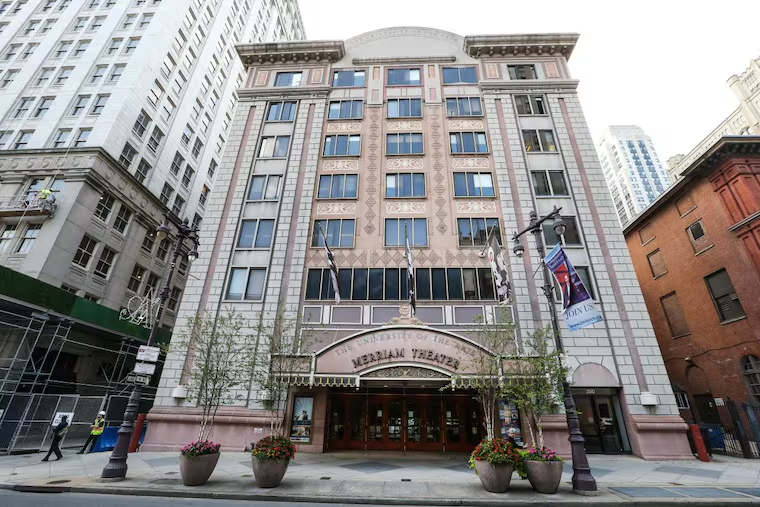Kimmel Center scraps plan for tower above Merriam Theater
The Kimmel Center, which bought the Merriam in 2016, failed to attract any proposals from developers. A planned renovation could move some PA Ballet productions elsewhere.

After failing to attract any proposals from developers, the Kimmel Center will not be proceeding with a project that would have demolished the office-building portion of the Merriam Theater building, put a new tower in its place, and cantilevered the new tower over the old remaining theater itself.
The arts center, which acquired the Merriam in 2016, had hoped that the base of the tower would have served in part as a lobby and space for amenities for the theater, and that proceeds generated by air rights to a residential tower above could have helped to finance renovations of the theater.
Nine developers “expressed interest” in the Kimmel’s request for proposals, said Kimmel president Anne Ewers, and eight signed nondisclosure agreements and began working on the RFP.
“But one by one they realized that the extra cost of construction in Philadelphia plus the current real estate market and complexity of what we were asking with cantilevering over the theater, that they couldn’t make the numbers work,” she said.
The proposed tower, which could have been as high as 32 stories, also drew scrutiny from residents of neighboring buildings, some of whom said they were considering legal action to stop the project.
» READ MORE: Our report from the first public meeting seeking comments on the proposal
The Kimmel still plans to renovate the Merriam, which it bought from the University of the Arts in 2016 for $11 million. Now, though, with the tower idea scrapped and no money coming from air rights, Ewers says the Kimmel hopes to cover the costs of the renovation through the sale of naming rights.
Previously the Kimmel had planned to finance the project through the combination of naming rights and air rights from the tower.
The Kimmel had already begun a larger program to sell naming rights to parts of the facility, from lobby spaces to the glass dome to the entire Kimmel campus itself. In 2015, the Kimmel revealed a study that identified more than $100 million in potential naming opportunities. So far, though, the arts center has not been able to draw a naming sponsor for any major component.
“It has taken much longer than we anticipated, but we are still working,” said Ewers. “We have interested parties, but no agreements.”
Performances in the Merriam, which opened in 1918 as the Sam S. Shubert Theatre, continue. A renovation project would displace Pennsylvania Ballet, which performs two programs there each season, with others at the Academy of Music.
Ballet leaders have not figured out where those performances would happen, and whether the displacement would force the company to restructure its season.
The ballet might move its Merriam performances to the Kimmel’s Perelman Theater, or explore other spaces in the city, says Pennsylvania Ballet executive director Shelly Power.
The ballet generally draws audiences of between 900 and 1,000 to its mixed-repertoire performances in the 1,800-seat Merriam, and the Perelman capacity is around 550, so if it moved some programs to the Perelman the number of performances might be increased.
The ballet is also viewing the shuffle as a chance to explore artistic collaborations with other genres, like opera and chamber music, with groups already in residence at the Perelman. “We’re trying to work with the Kimmel Center first because we’re a resident company,” said Power.
Renovations to the Broad Street-facing part of the building could start as soon as the spring of 2020, with major theater renovations beginning in the summer of 2021, a Kimmel spokesperson said.
The erection of a tower would have solved an architectural problem at the Merriam. The levels of seating in the theater don’t align exactly with those of the part of the building fronting Broad Street, making access to some seats difficult. Lobby and amenity spaces are also quite modest.
Demolishing the Broad Street side of the building and replacing it would have put in place a tower whose base was split between an entrance to residences and lobby/amenity spaces for Merriam patrons.
Now, figuring out “more logical” circulation paths and a “more gracious entrance” to the theater for audience members are the goals, along with stage house improvements and renovation of the auditorium, said architect Richard Maimon, a partner at KieranTimberlake. But no exact plan has been worked out yet, he said.
Though the purchase price of the Merriam was $11 million, the deal cost the Kimmel a total of $15 million including closing costs, financing, and some initial repairs and improvements. It was covered through $5 million in donations from 24 Kimmel board members, a $5 million grant from the William Penn Foundation, and a $5 million loan.